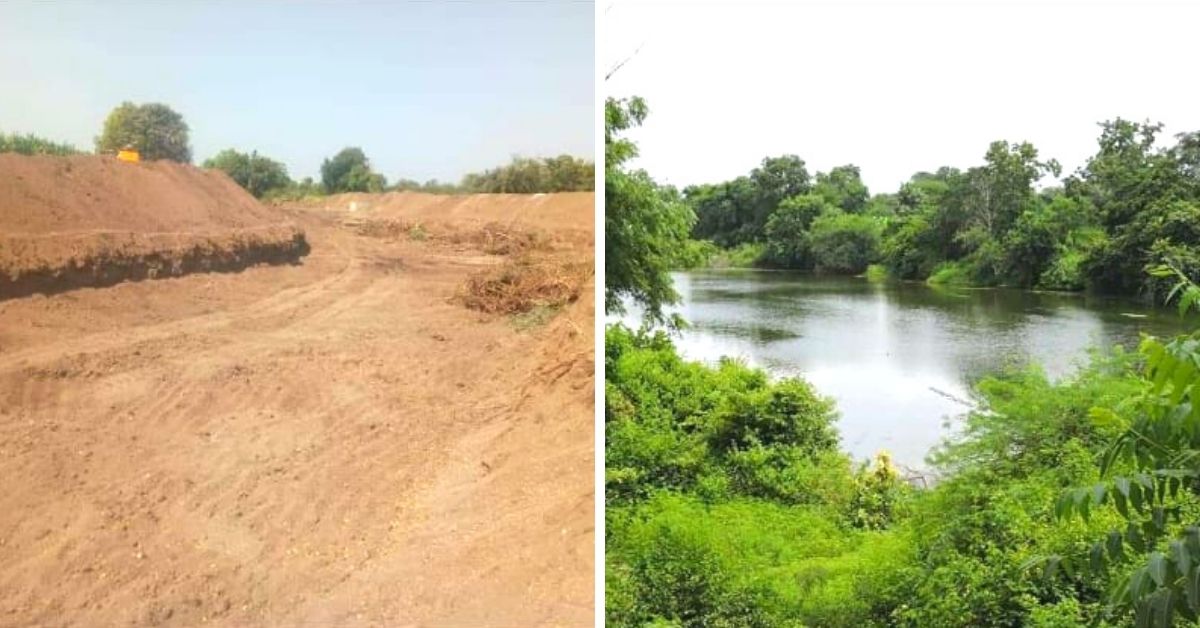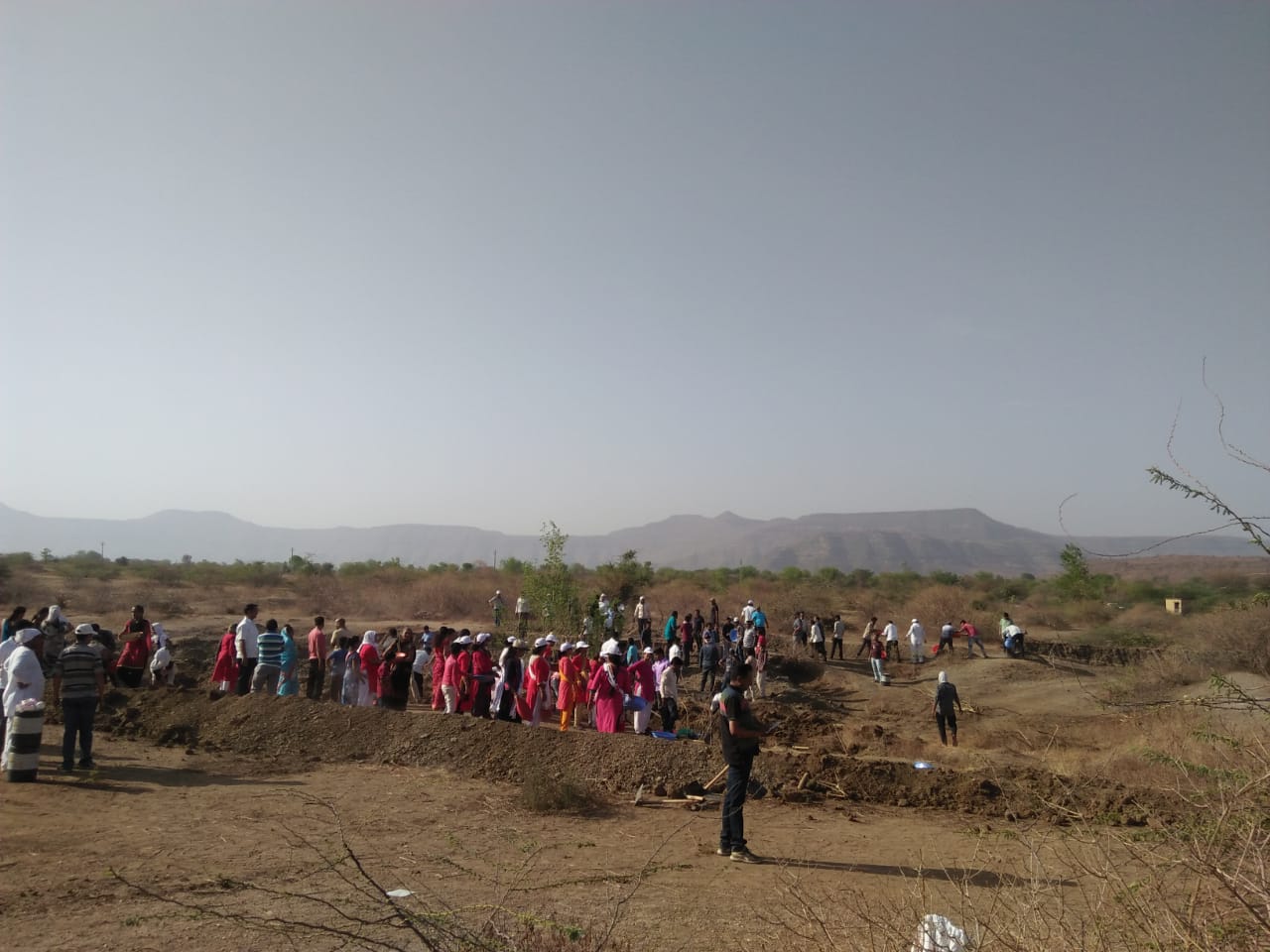IRS Officer Saves 102 Cr Litres of Water, Makes 16 Villages Drought-Free in 3 Years
Dr Ujjwal Chavan, Joint Commissioner of Income Tax, Mumbai, has run a massive water conservation initiative to rejuvenate the river and improve groundwater tables in several Maharashtra villages, including Dhamangaon, where he is originally from. His efforts have benefited around 30,000 farmers so far.

In 2016, a debt-ridden farmer from Maharashtra’s Dhamangaon village died by suicide, after he failed to generate any income from his 40-acre farm.
The local river had dried up, and this, coupled with insufficient rainfall, left him with no other choice than to take the extreme step. While this was the first and only suicide case reported in the agrarian village, the drought problem has been prevalent for the last two decades. Unchecked groundwater extraction has led to an imbalance in the ecosystem, preventing rainfall catchment.
Dr Ujjwal Chavan, Joint Commissioner of Income Tax in Mumbai, who is originally from Dhamangaon, was shocked by the farmer’s death.
A year later, he launched an ambitious water conservation project in the village to rejuvenate the river and improve groundwater tables. He spent the next year travelling to the village over the weekends, to mobilise villagers and start the construction of water reservoirs and small dams.
Today, the village is drought-free, and can store 22 crore litres of water, which suffices the area’s water needs for 10 months. The 2010-batch IRS officer has also implemented the same model in 16 other villages of Jalgaon district, making all of them drought-free within three years.
“It was a joint effort,” Chavan tells The Better India, and adds, “Various stakeholders, including the village people, the district administration, tehsildars, NGOs and school teachers, worked in unison to achieve the target. All of them were motivated by the water crisis, which had disrupted many lives.”

It is not uncommon for civil service officers like Chavan, who are inspired by their own experiences, to go the extra mile. His father was a farmer and mother, a school teacher. So while growing up, Chavan was exposed to both deplorable farming conditions as well as the importance of education. He always wanted to join the civil services to bring about grassroots changes. However, he studied MBBS before attempting the UPSC in 2010.
Before delving into how Chavan achieved the impressive feat, here’s a brief about the acute water shortage that hampers the livelihoods of thousands.
Agriculture: Disguised unemployment
Things drastically changed in the late nineties, when several farmers in Chavan’s village, including his maternal grandparents, shifted from the two-crop system to one. This was a direct result of rampant digging of wells to extract groundwater in the absence of sufficient water supply from the river.

“There were no poclain machines 30 years ago, so villagers manually dug the wells without realising the extent of the damage. The depth of the wells went as deep as 70 feet, which triggered a severe water crisis. Farmers were able to farm only during monsoons, and there was no income for the rest of the year. This led to forced migration to urban areas for livelihood. Only the elderly remained in the village, and there was hardly any expenditure. This limited the economic cycle of our village, and we had no savings. Before we knew, we were trapped in a vicious cycle,” says Tushar Nikam, a resident of Dhamangaon. Tushar is one of the core members of Chavan’s conservation project.
Another reason behind water deficiency was the establishment of cotton plantations when the area switched from millets to the former. Cotton requires a lot of water. So even though the supply of water remained the same, the demand increased exponentially, thus creating a disbalance.
To sum it up, a majority of the farmers in the village, irrespective of how much land they owned, lived hand-to-mouth.
A water conservation tale that benefited 30,000 farmers

Knowing that awareness was key, Chavan first mobilised a select number of farmers and school teachers. When he went to people with the proposition, he was met with apprehensions. There had never been government intervention at such a large scale before, so naturally, people suspected Chavan’s motivation, even though he was once a native. It took months before people came on board.
Next, he arranged for finances by availing the Jalyukt Shivar Abhiyan. The scheme involves the deepening and widening of streams, and the construction of cement and earthen stop dams.
“With everyone’s dedicated efforts, we launched the project in 2017. We dug and widened the small rivulets to create storage capacity. Surface water reservoirs were made by constructing minor dams across the rivulets. Bunds were made using porous Moorum soil, which facilitates easy percolation of rainwater into the ground,” Chavan explains.
It took a little over a year to show the results. Three to four counts of rainfall were enough to fill the rivulets, and this time, instead of the water running off, it was captured in the reservoirs. Under each reservoir, the groundwater was recharged up to a radius of 500 metres. The water level today stands at just five feet.
The same model was replicated across 16 drought-prone villages over the course of three years. However, from the second year onwards, Chavan roped in villagers to finance half the project to integrate a sense of ownership. Every farmer donated money, starting from Rs 1,000, after they realised the long-term benefits of reservoirs and dams. Thirty reservoirs were built in every village, benefiting a total of 30,000 farmers.
Mission 500

In the next two years, Chavan aims to scale his water conservation project across 65 villages and create storage capacity of 500 crore litres of water. For the same, he has already started training 11 villagers, who will in turn train five villagers from each village. He says this will help increase manpower, and quicken the mobilisation process. He is also arranging for sponsors and NGOs to help him in the mission.
Despite being swamped with work in the maxim city, Chavan never fails to visit the villages and follow up on the progress. He spends every alternate weekend with the villagers, who are as dedicated as he is. “I believe people’s goodwill and excitement to undo years of damage is what keeps me going,” he says.
Image credits:
Edited by Divya Sethu
If you found our stories insightful, informative, or even just enjoyable, we invite you to consider making a voluntary payment to support the work we do at The Better India. Your contribution helps us continue producing quality content that educates, inspires, and drives positive change.
Choose one of the payment options below for your contribution-
By paying for the stories you value, you directly contribute to sustaining our efforts focused on making a difference in the world. Together, let’s ensure that impactful stories continue to be told and shared, enriching lives and communities alike.
Thank you for your support. Here are some frequently asked questions you might find helpful to know why you are contributing?


This story made me
-
97
-
121
-
89
-
167













